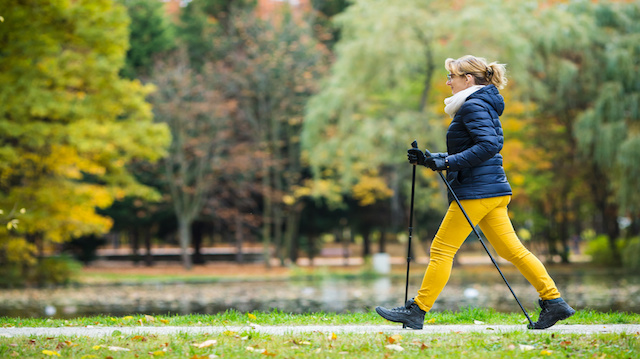
The simple act of walking at a brisk pace may be beneficial for decreasing your body mass index (BMI), according to a new study from the London School of Economics (LSE). The recent research found that walking at a brisk pace might even be more beneficial than doing other physical activities, including working out at the gym.
The study, published online in Risk Analysis (2015) examined reports from the annual Health Survey for England. Lead researcher Dr. Grace Lordan, a specialist in health economics, and colleagues, compiled data from the survey covering the period between 1999 and 2012. Lordan analyzed reported physical activity from the survey, specifically activities that raised participants’ heart rates to that of moderate, perspiring levels.
Researchers then compared physical activity data with the participants’ BMI and waist measurements, which was also collected in the annual survey. They found that both male and female participants who had lower BMIs and smaller midsections walked briskly 30 minutes per day, five days a week. “We show that individuals who walk at a brisk or fast pace are more likely to have a lower weight when compared to individuals doing other activities,” the study concluded. The research also found that female participants over the age of 50 and participants with lower incomes benefited more from walking.
Walking may just be an exceptional alternative to the gym when done consistently as outlined in the study. The U.S. is seeing a growing rate of obesity and the chronic diseases associated with it, including diabetes and heart disease. The American Heart Association (AHA) already recommends 30 minutes per day of moderate exercise, five times a week for heart health. Walking at a brisk pace is noted as moderate exercise, according to the AHA.
 Walking also boasts a number of other health benefits besides keeping your waistline slim. Walking lowers your blood pressure, boosts your immune function, strengthens your bones and muscles, and also lifts your mood, according to the National Institute of Diabetes and Digestive and Kidney Diseases. Walking is also free, which means there is little excuse not to lace up your shoes and take a brisk stroll around your neighborhood park.
Walking also boasts a number of other health benefits besides keeping your waistline slim. Walking lowers your blood pressure, boosts your immune function, strengthens your bones and muscles, and also lifts your mood, according to the National Institute of Diabetes and Digestive and Kidney Diseases. Walking is also free, which means there is little excuse not to lace up your shoes and take a brisk stroll around your neighborhood park.
Walking is also a fun alternative to add to your morning routine. I wake up before people stir from their beds and the cars fill the streets. It gives me a chance to breathe in the crisp morning air, listen to a few tunes or a podcast, and sort through my daily schedule in my mind before cracking open the laptop.
You can also have a few friends tag along on your routine walks, making it a group activity and an exceptional way to hold one another accountable for going 30 minutes daily. Walking to and around places you enjoy is another way to spice up your routine and keep you motivated.
Where do you walk and why?
-Stephen Seifert
Stephen Seifert is a writer, professor, adventurer and a health & fitness guru. His flare for travel and outdoor adventure allows him to enjoy culture and traditions different than his own. A healthy diet, routine fitness and constant mental development is the cornerstone to Stephen’s life.
Sources:
http://onlinelibrary.wiley.com/doi/10.1111/risa.12417/abstract
http://www.lse.ac.uk/newsAndMedia/news/archives/2015/11/Regular-brisk-walking-is-best-exercise-for-keeping-weight-down,-says-LSE-research.aspx
http://www.heart.org/HEARTORG/GettingHealthy/PhysicalActivity/FitnessBasics/American-Heart-Association-Recommendations-for-Physical-Activity-in-Adults_UCM_307976_Article.jsp#.VjuoT9DY2fQ
http://www.niddk.nih.gov/health-information/health-topics/weight-control/walking-step-right-direction/Pages/walking-step-right-direction.aspx

